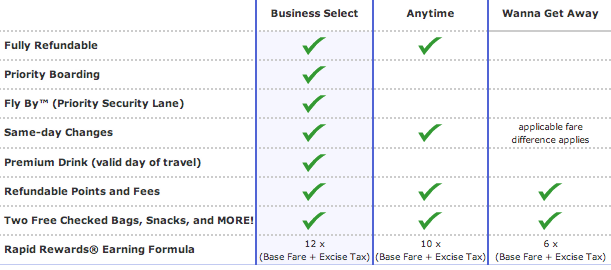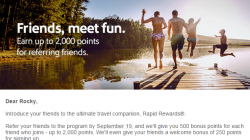To continue yesterday’s discussion of how to get free upgrades, let’s swing to the other side of the spectrum. Southwest Airlines has a large fan base but doesn’t offer any of the trappings of a typical airline. There are no first class seats, no confirmed seat assignments, no extra legroom seats, no meals, no international award flights… I could go on but you get my point. How does this airline manage to stay so popular, yet why do so few travel bloggers write about it?
The Case for Infrequent Travelers
Many of Southwest’s fans are infrequent travelers. This post was inspired by a recent thread on FlyerTalk, but in the past week I’ve also been hearing stories from my own family, who like Southwest precisely because they don’t offer all these elite trappings that make an infrequent traveler feel like a second class citizen.
It helps Southwest’s reputation that ancillary fee revenue is limited, so you don’t feel like you’re being nickel and dimed everywhere along the journey. Although some might compare Southwest with budget airlines Allegiant and Spirit, these latter two rely heavily on such fees to compensate for lower fares. Instead, Southwest really operates in an entirely separate class from discounters and legacy airlines.
Fares are sold in only three classes: deep-discount Wanna Get Away fares, regular Anytime fares, and full service Business Select fares. Fares can be canceled and changed at anytime without paying a fee, although certain fares may only return your money in the form of a future credit. And the rewards system is extremely easy to figure out, essentially working as a fixed rebate with no blackout dates.
Most of the time when I fly to Texas or California, two states with a large Southwest presence, I find that fares actually aren’t any cheaper compared to United, and they may even be higher. Southwest is benefiting from a perception it has created among its consumers that it is a friendly, affordable option that isn’t out to deceive you. Having established this image early as a discounter, it has more recently been able to raise its prices while maintaining services like free checked baggage in part because people no longer question it.
By not including its fares in global distribution systems (GDSs) like Apollo or Sabre, you are forced to visit Southwest’s website. Many consumers will go to Southwest and only Southwest, without actually performing a comparison. This helps maintain loyalty, and to be fair, Southwest hasn’t really done anything to risk losing it.
The Case for Business Travelers
You’ll have to help me out here if I miss some things because as a frequent traveler, I avoid Southwest precisely because it doesn’t have any of the perks I love about United or American. But that doesn’t mean it has nothing to offer road warriors. I was talking a friend last weekend who flies Southwest almost every week for his job and loves it.
While you’ll still be stuck in an economy class seat, Southwest has some of the better seats out there in economy cabins and was a leader in offering all-leather seats since copied by JetBlue and American. Business Select fares include access to priority security and boarding, and same day changes are less restrictive. You even get a free alcoholic beverage, just like on the other airlines–though you could argue that quantity is more limited.
If you fly often enough, you can attain two forms of elite status called A-List (35,000 miles per year) and A-List Preferred (75,000 miles).
A-List members receive:
- Priority Boarding
- Priority Check-In and Security
- Standby Priority
- Dedicated Phone Support
- 25% Bonus Points
A-List Preferred members receive:
- Above Benefits
- 100% Bonus Points
- Free In-flight WiFi
Southwest’s no-hassle policy wins it fans among infrequent travelers who don’t understand the dozens of rules at other airlines and from business travelers who don’t have the time to deal with a bureaucratic ogre. The benefits of elite status may not seem like much in the absence of a first class cabin, but if you listen to the top-tier elites at other airlines complain about the stress and uncertainty surrounding their spot on the upgrade list, it doesn’t seem so bad.
A potential downside is that Southwest also doesn’t have a lot of long, nonstop flights. It doesn’t even have hubs. You can expect to spend more time connecting even on routes that would be nonstop with most other carriers. And with the tight turnaround times that Southwest builds into its schedules, an early morning delay in one city could ripple through the rest of the system by evening.
In general, Southwest is going to work best for business people whose travel is almost exclusively domestic and covers distances of 500 to 2,000 miles. You might also appreciate that it operates Boeing 737 aircraft exclusively, so you will never be stuck with a regional jet on a less-trafficked route.
The Benefits and Drawbacks of Rapid Rewards
If you fly 110,000 miles in one year you not only earn A-List Preferred status but also an annual companion pass that will allow you to bring a friend or family member (the same one) with you on all your trips for free. This includes award travel, effectively cutting the cost of your awards in half.
I mentioned earlier that there are three different fare classes on Southwest. The cheapest fares earn 6 points per dollar, middle fares earn 10 points per dollar, and the expensive business fares earn 12 points per dollar. Add on to this the elite bonuses, and you have your earnings. For example, a $300 ticket will earn 1,800 points if it’s a Wanna Get Away and you have no status. A Business Select fare on the same flight for an A-List Preferred passenger may cost $500 and earn 12,000 points.
Like earnings, redemption is based solely on the type and cost of the fare. Wanna Get Away fares cost 60 points per dollar, Anytime fares cost 100 points per dollar, and Business Select fares cost 120 points per dollar. Notice a pattern? You’re getting about a 10% rebate before factoring in elite bonuses. Redeeming for that $300 Wanna Get Away ticket as an award will cost 18,000 points, and that $500 Business Select ticket will cost 60,000 points. (Note the benefit of elite status: your rebate is effectively doubled to 20% as an A-List Preferred thanks to the earnings bonus)
The downside is that you’re only getting a rebate in the range of 10-20%. This is why travel blogs and sites like MilePoint and FlyerTalk don’t discuss Southwest as much as the other programs. There are few opportunities for manipulation, and there are no aspirational awards to be had.
I mentioned yesterday that on a legacy airline like United I could take a spare $400, fly two mileage runs, earn a bunch of elite qualifying miles, and also earn enough redeemable miles for a $500 domestic ticket. That is, the miles could potentially be worth more than I paid to earn them. If I were to save them for an international award in a premium cabin, they could be worth even more.
I recently booked two first class tickets on Singapore Airlines to Singapore and Hong Kong. It cost me 160,000 miles per person for a flight that normally retails at over $12,000. That is a value of over 7.5 cents per mile that cost far, far less to acquire. You will never be able to redeem Southwest Airlines points for more than you paid for them.
How to Make Rapid Rewards Work for You
The one case where you might be able to manipulate Rapid Rewards is by taking advantage of the credit card sign-up bonuses, which several people have reported DO contribute to your annual tier qualifying miles. Bonuses go up and down, but recently these were increased to 50,000 points for the personal and business credit cards. Although they are both offered by Chase, generally you can apply for them on the same day and still get approved.
Even a small business can be enough to get a business card approved using your Social Security number instead of an Employer ID Number (EIN). Just be prepared to get a call asking you to explain the amount and regularity of your income. Even so, my business card has the smallest credit line of any of my cards.
If you can get approved for both cards, that’s 100,000 points right there, enough for $1,670 in Wanna Get Away fares. You are also only 10,000 points away from a free companion pass. Since that pass extends to award travel, it would effectively turn your balance into 220,000 points for the next year, which means a lot of free trips.
If you would like to apply for these cards, the links on my Credit Cards page have the best offers I’m aware of. On the other hand, I’ll talk tomorrow about why these shouldn’t be your primary credit cards for earning and burning Rapid Rewards points. As always, please email or post questions if you have any concerns about how Southwest and Rapid Rewards might be a good fit for your travel habits.





